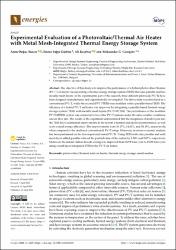| dc.contributor.author | Tuncer, Azim Doğuş | |
| dc.contributor.author | Gürbüz, Emine Yağız | |
| dc.contributor.author | Keçebaş, Ali | |
| dc.contributor.author | Georgiev, Aleksandar G. | |
| dc.date.accessioned | 2023-05-25T12:26:21Z | |
| dc.date.available | 2023-05-25T12:26:21Z | |
| dc.date.issued | 2023 | en_US |
| dc.identifier.citation | Tuncer, Azim Doğuş, Emine Yağız Gürbüz, Ali Keçebaş, and Aleksandar G. Georgiev. 2023. "Experimental Evaluation of a Photovoltaic/Thermal Air Heater with Metal Mesh-Integrated Thermal Energy Storage System" Energies 16, no. 8: 3449. https://doi.org/10.3390/en16083449 | en_US |
| dc.identifier.issn | 19961073 | |
| dc.identifier.uri | https://doi.org/10.3390/en16083449 | |
| dc.identifier.uri | https://hdl.handle.net/20.500.12809/10715 | |
| dc.description.abstract | he objective of this study is to improve the performance of a hybrid photovoltaic/thermal (PV/T) air heater incorporating a thermal energy storage system (TESS) that uses paraffin and has metallic mesh layers. In the experimental part of the research, three different pilot-scale PV/Ts have been designed, manufactured, and experimentally investigated. The first system was structured as a conventional PV/T, while the second (PVT/TESS) was modified with a paraffin-based TESS. The efficiency of a hybrid PV/T air heater was improved by integrating a paraffin-based thermal energy storage system (TESS) with metallic mesh layers (PV/T-MTESS). The performance of the modified PV/T-MTESS system was compared to two other PV/T systems under the same weather conditions and air flow rate. The results of the experiment demonstrated that the integration of mesh layers into the TESS led to substantial improvements in the system’s thermal and electrical performance, as well as its overall exergy efficiency. The improvements were 33.17%, 14.82%, and 58.15%, respectively, when compared to the unaltered (conventional) PV/T setup. Moreover, an enviro-economic analysis has been performed on the developed and tested PV/Ts. Using TESS with only paraffin and with mesh layer-added paraffin reduced the payback time of the system by 2.54% and 9.85%, respectively. Moreover, the annual carbon dioxide saving was improved from 0.079 tons/year to 0.103 tons/year using a mesh layer-integrated TESS in the PV/T air heater. | en_US |
| dc.item-language.iso | eng | en_US |
| dc.publisher | MDPI | en_US |
| dc.relation.isversionof | 10.3390/en16083449 | en_US |
| dc.item-rights | info:eu-repo/semantics/openAccess | en_US |
| dc.subject | Photovoltaic/thermal | en_US |
| dc.subject | Solar air heater | en_US |
| dc.subject | Thermal energy storage | en_US |
| dc.subject | Metal meshes | en_US |
| dc.title | Experimental Evaluation of a Photovoltaic/Thermal Air Heater with Metal Mesh-Integrated Thermal Energy Storage System | en_US |
| dc.item-type | article | en_US |
| dc.contributor.department | MÜ, Teknoloji Fakültesi, Enerji Sistemleri Mühendisliği Bölümü | en_US |
| dc.contributor.authorID | 0000-0003-4809-2461 | en_US |
| dc.contributor.authorID | 0000-0002-5200-8536 | en_US |
| dc.contributor.institutionauthor | Gürbüz, Emine Yağız | |
| dc.contributor.institutionauthor | Keçebaş, Ali | |
| dc.identifier.volume | 16 | en_US |
| dc.identifier.issue | 8 | en_US |
| dc.relation.journal | Energies | en_US |
| dc.relation.publicationcategory | Makale - Uluslararası Hakemli Dergi - Kurum Öğretim Elemanı | en_US |


















